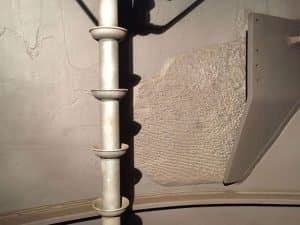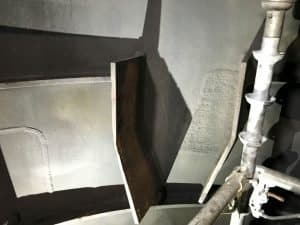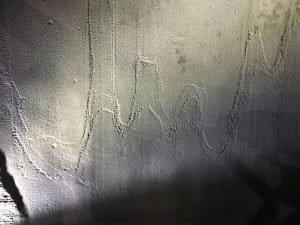HVTS Stops Sour Water Stripper Corrosion
Summary
A case study of mitigating sour water stripper corrosion using on-site alloy upgrade during turnaround.
Unplanned Shutdown of the Sour Water Stripper Column
During December 2017, a US Refinery experienced in-service failure of their Sour Water Stripper column. This was an unplanned shutdown, consequently causing other equipment to stop, compounding the effect of this outage. The inspection of the column revealed corrosion on the shell between the first and seventh tray. Extensive corrosion was also found behind vertical downcomers.
Sour Water Stripper Corrosion Problem
Ammonia (NH3) and hydrogen sulphide (H2S) are key “bad actors” attacking the sour water stripper. Refinery experienced in-service failure of their Sour Water Stripper column. During this unplanned shutdown, various sections of the column were cut and replaced. Other areas, found to be below minimum thickness spec, were repaired with weld metal build-up. The refinery also needed a long-term strategy to protect the rest of the exposed shell against sour water corrosion with a corrosion resistant alloy.
Rapid Mobilization and On-Site Alloy Upgrade
IGS was contracted to apply a High-Velocity Thermal Spray (HVTS) Alloy Cladding to prevent further NH3 and H2S corrosion attack on the column shell. IGS specializes on providing its service on-site during turnarounds in all continents except Antarctic. IGS project team has been able to mobilize in a short time and support the refinery with high alloy cladding on the sour water stripper shell. The material applied is a high Nickel Chrome Molybdenum alloy for pitting resistance with reduced stress and oxide formation.
Corrosion Mitigation Options
The refinery was looking for a robust corrosion resistant alloy which would resist sour water corrosion and facilitate the column’s quick return to service. Welding repair would have required post weld heat treatment. Organic coating application was not feasible as it would have taken days to cure due to low ambient temperatures (50°F / 10°C).

Agile Corrosion Resistant Alloy Protection
IGS Alloy Cladding was applied utilizing a High-Velocity Thermal Spray (HVTS) process. HVTS exhibits very high bond strength and does not require a bond coat. The bond interface is mechanical and does not create any heat affected zones (HAZ), therefore there is no need for post weld heat treatment.
1003ft² (93m²) area of the sour water stripper column was protected in 2 ½ days in 5 shifts. The project was executed in accordance with the IGS Safety Program. Safety is Integrated Global Services’ first and highest priority. IGS performed work per the approved QCP/ITP on a 24hr basis by having a dayshift and nightshift crew on site.
Sour Water Stripper Column Corrosion Protection Schedule
The scope area started from Tray 7 (Chimney tray) up to Tray 1, including the dome, two manways and an 8” nozzle in the elliptical head. Other areas included downcomers, obstructions, and tray rings. The total area protected with a corrosion resistant alloy was 1003ft² (93m²). Operators performed grit blasting and cladding activities for five twelve-hour shifts in the unit during dayshift and nightshift.


Sour Water Stripper Column – First Inspection
Hydrogen flux monitoring inspection has since been completed to verify the performance of HVTS protection. All readings were found to be acceptable, within IGS recommendations, and did not indicate any signs of corrosion.
Inspection During 2020 Shutdown
The HVTS cladding was found to be in as-sprayed condition. There was no sign of defects, blisters, cracks, or spalling. During the inspection, close attention was paid to the areas behind the down comers as well as the weld buildup sections. These areas were all in good condition and within thickness specification

IGS Experience and Expertise
IGS stops corrosion mechanisms such as pitting and crevice corrosion, flow enhanced corrosion and general corrosion loss in amine vessels, knockout drums, crude desalters and other process vessels, towers, and columns. We use High Velocity Thermal Spray (HVTS) applied Alloy Cladding of high nobility Corrosion Resistant Alloys (CRAs) in-situ to protect existing columns during turnarounds.
Since 2001, IGS has protected ~100 of amine units for upstream and downstream operations, internally cladding more than 3000 m² of steel. HVTS is faster than welding, with no heat affected zones and no need for PWHT.
Unlike organic coating systems, HVTS metal claddings are robust, long-term and durable with high mechanical toughness, abrasion resistance and wide service temperature and pressure ranges, resistant to vessel steam-out and cleaning processes. We utilize our equipment and technology to apply corrosion resistant alloys almost anywhere in the world.
IGS carefully controls and monitors our application standards through strict QA/QC protocols. IGS generates an electronic thickness record on a defined reference grid across the clad area. This record is used for future inspection and verification of the internal cladding integrity. We have also developed inspection technologies for external, on-line verification of the cladding condition.
Related Case Studies:
Column Shell Corrosion Protection Verified
Gas Turbine Corrosion Mitigated by HVTS and Hex Chrome Filtration System
HVTS Prevents Corrosion Attack in a Regenerator Column at LNG Plant
H2S Corrosion in an Upstream Separator Vessel Permanently Stopped
Severe Amine Column Corrosion Permanently Frozen
Caustic Vessel Protected After Repeated Failure
Free consultation with an IGS Subject Matter Expert
IGS is here to provide information, answer questions and create an effective solution for your needs.


